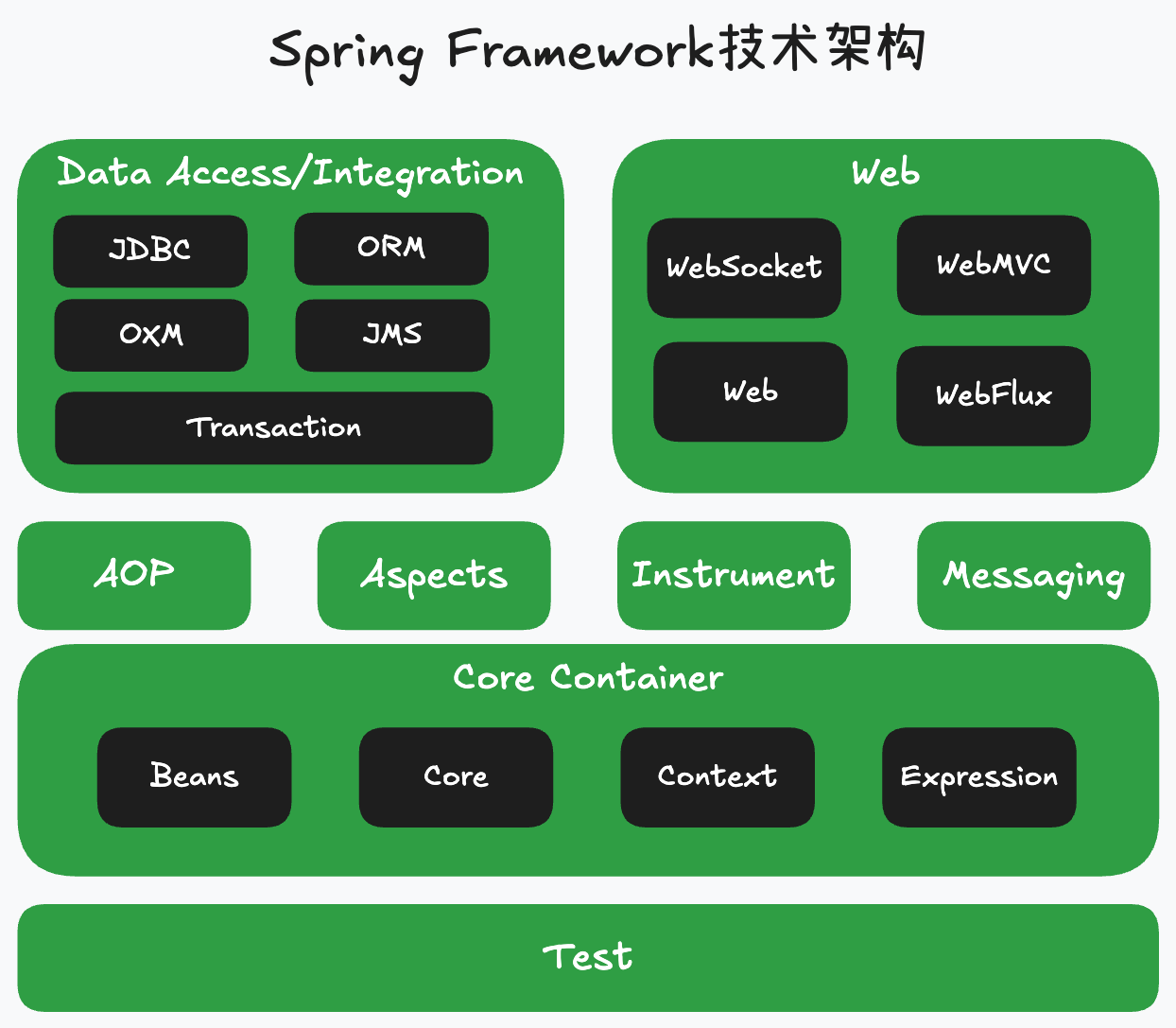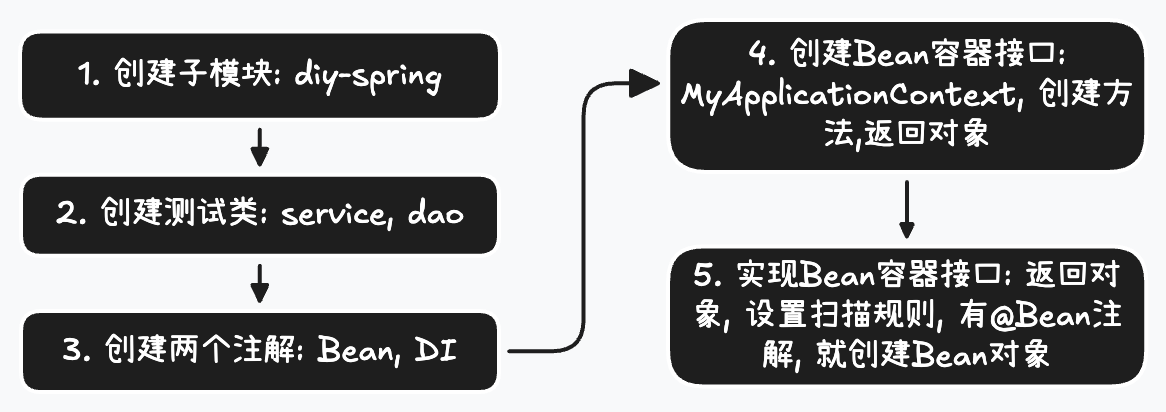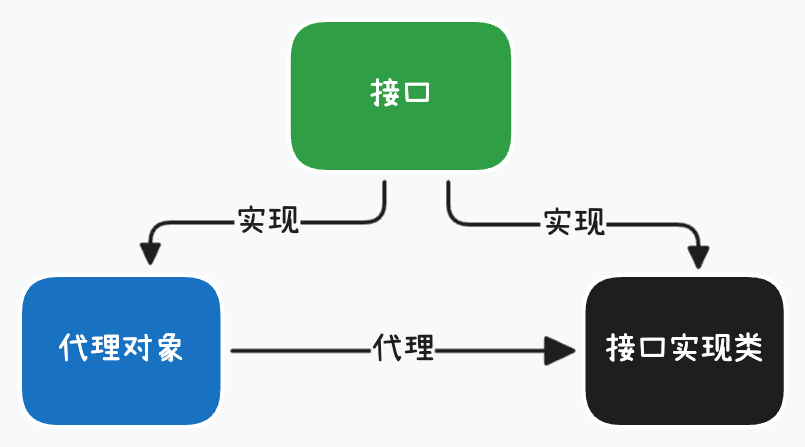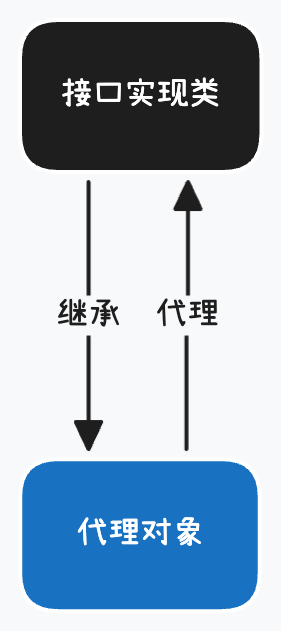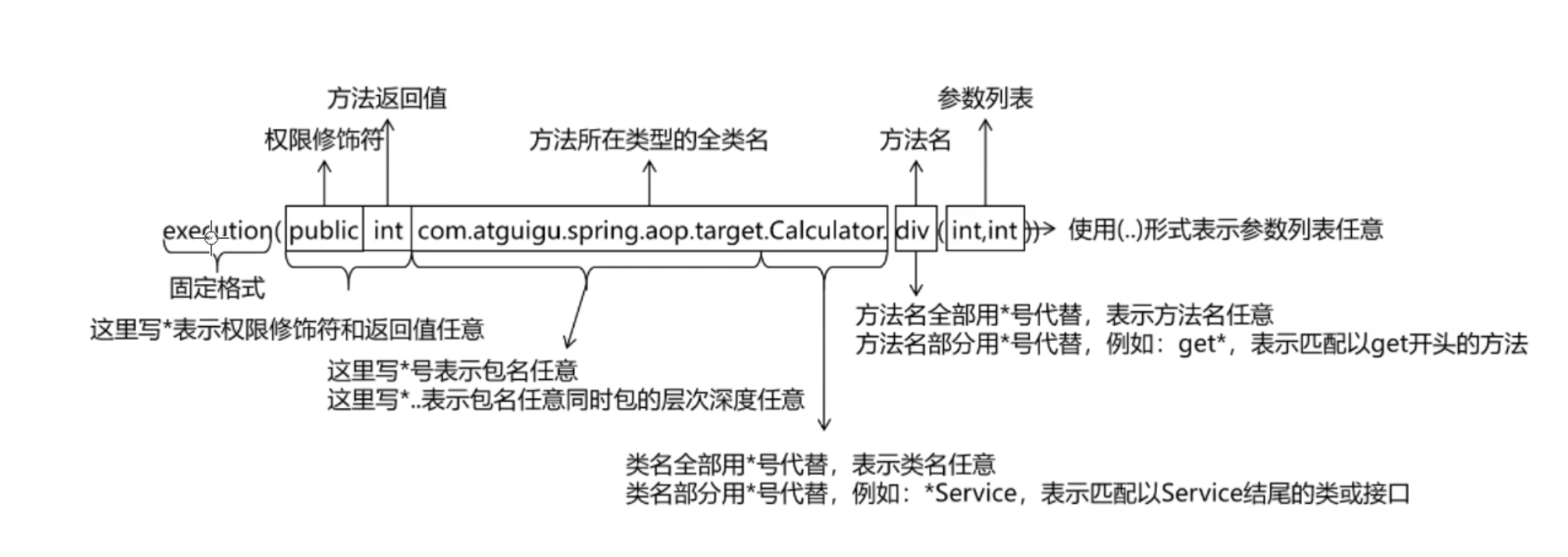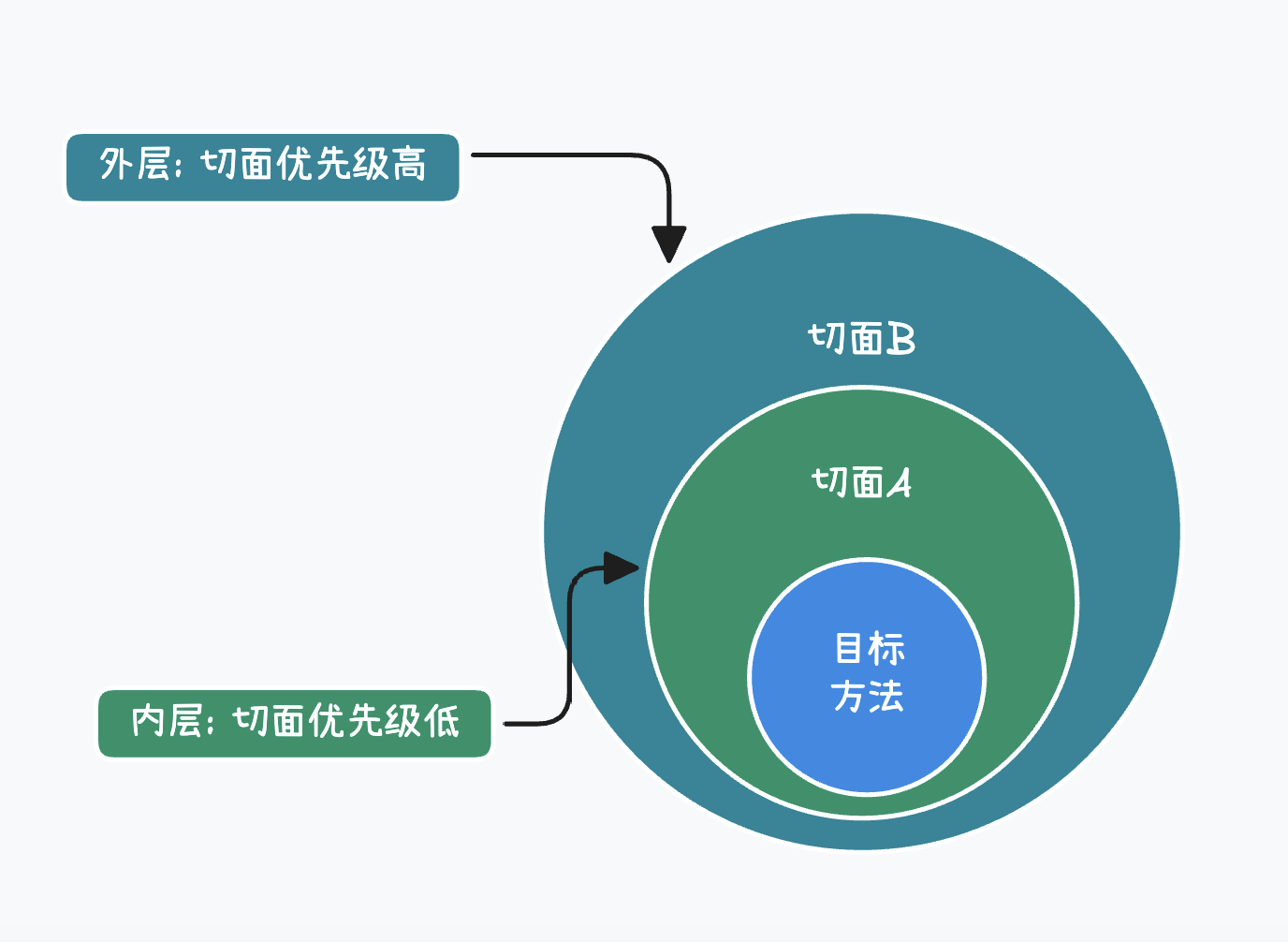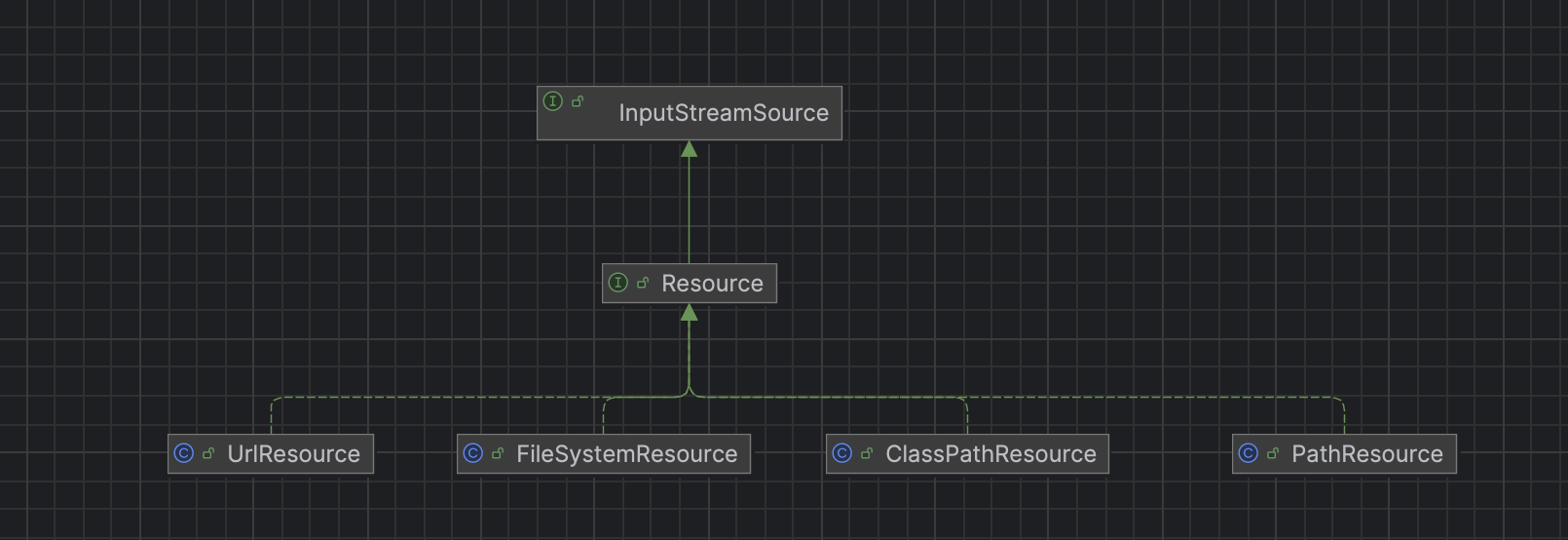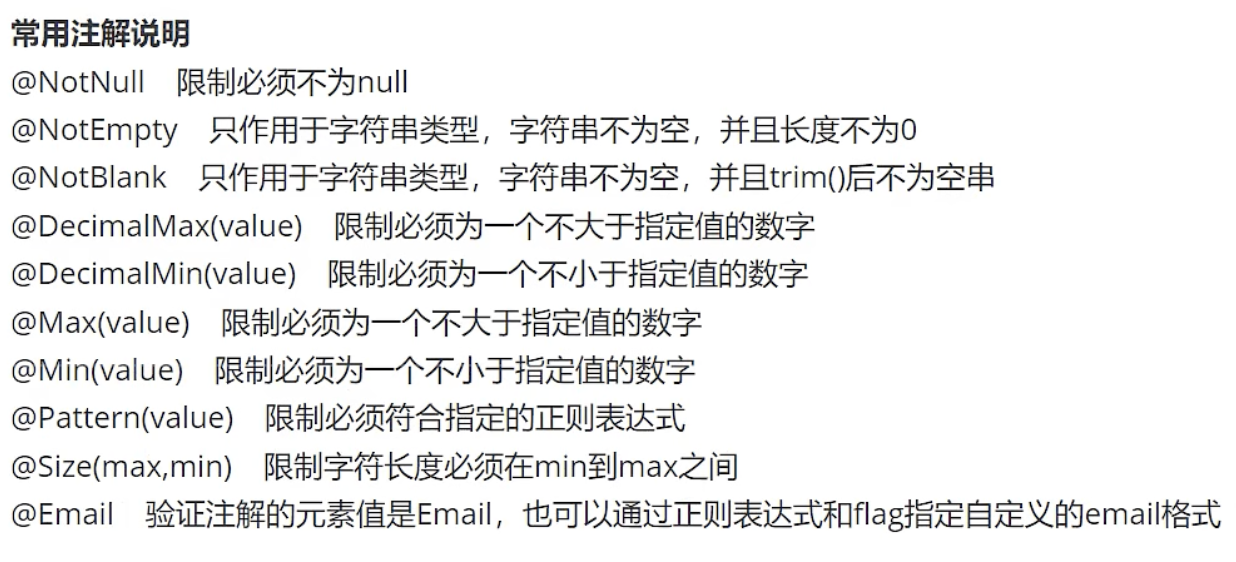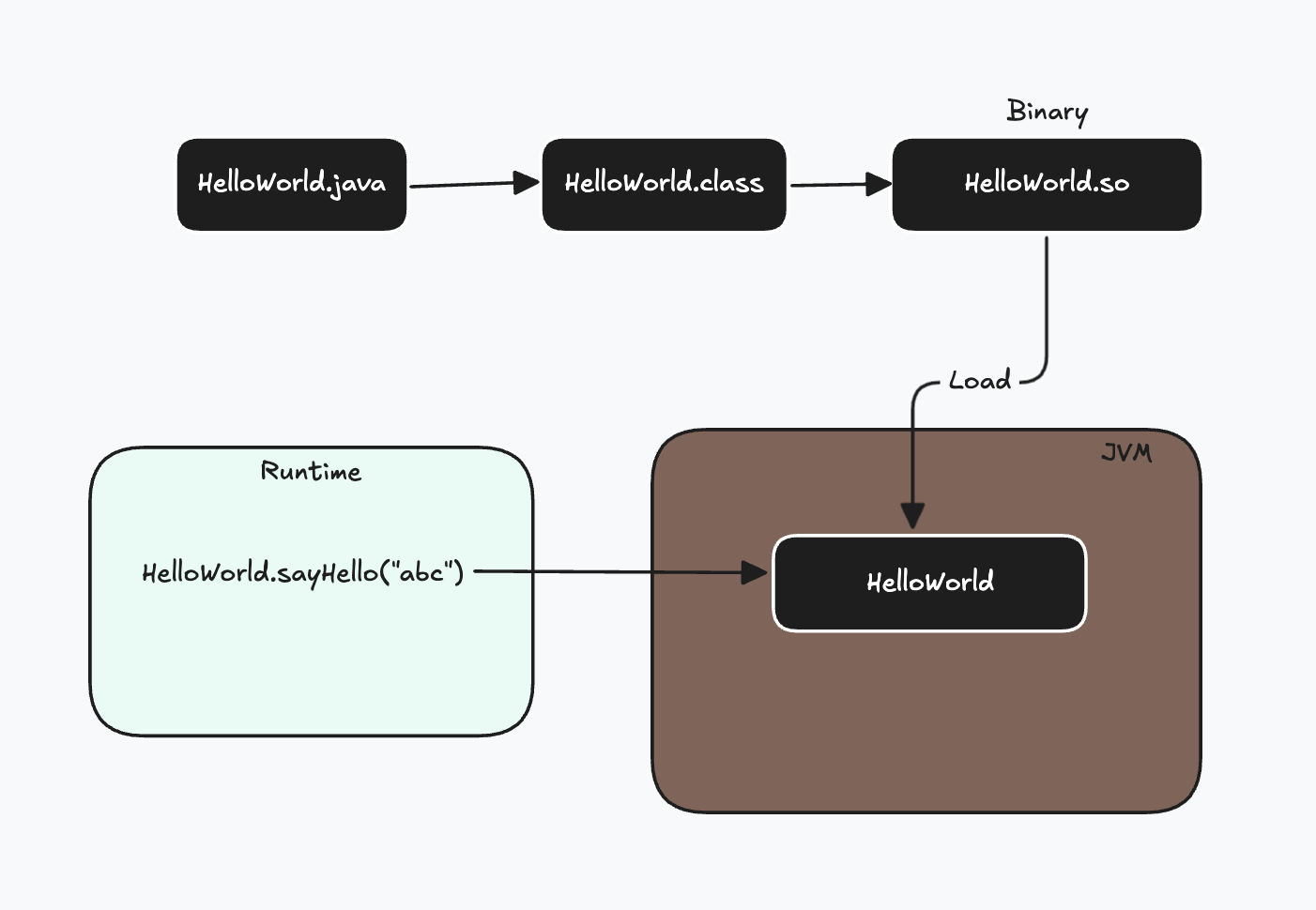Spring
Demo代码
1 概述 Spring是一款主流的Java EE轻量级开源框架
广义的Spring
狭义的Spring
1.1 Spring Framework特点
非侵入式: 使用Spring Framework开发应用时, Spring对应用程序本身的结构影响非常小, 对领域模型可以做到零污染; 对功能性组件也只需要使用几个简单的注解进行标记, 完全不会破坏原有结构, 反而能将组件结构进一步简化. 这就让Spring Frame开发应用程序时结构清晰, 简洁优雅.
控制反转: 框架创建对象
面向切面: 在不修改源代码的基础上增强代码功能
容器: Spring IoC是一个容器, 包含并管理组件对象的生命周期
组件化: Spring实现了使用简单的组件配置组合成一个复杂的应用, 在Spring中可以使用xml和注解组合这些对象
一站式: 可以整合各种开源框架
1.2 Spring模块组成
Spring Core
spring-core
spring-beans
spring-context
spring-expression
Spring AOP
spring-aop
spring-aspects
spring-instrument
Spring Data Access
spring-jdbc
spring-orm
spring-oxm
spring-jms
spring-tx
Spring Web
spring-web
spring-webmvc
spring-websocket
spring-webflux
Spring Message
spring-messaging
Spring Test
spring-test
1.3 Spring6特点 1.4 Log4j2日志概述 Apache Log4j2是一个开源的日志记录组件, 在工程中代替了system.out等打印语句, 是java中最流行的日志工具Log4j2主要由几个重要组件组成
日志信息的优先级
TRACE: 追踪, 是最低的日志级别, 相当于追踪程序的执行
DEBUG: 调试, 一般在开发中, 都将其设置为最低的日志级别
INFO: 信息, 输出一些重要信息, 使用较多
WARN: 警告, 输出警告信息
ERROR: 错误, 输出错误信息
FATAL: 严重错误
日志信息的输出目的地: 指定了日志的输出是在控制台还是文件中
日志信息的输出格式: 控制了日志信息的显示内容
引入log4j2
1 2 3 4 5 6 7 8 9 10 11 <dependency > <groupId > org.apache.logging.log4j</groupId > <artifactId > log4j-core</artifactId > <version > 2.19.0</version > </dependency > <dependency > <groupId > org.apache.logging.log4j</groupId > <artifactId > log4j-slf4j2-impl</artifactId > <version > 2.19.0</version > </dependency >
加载日志配置文件
使用日志
1 2 3 4 5 6 7 8 9 public class TestUser { Logger logger = LoggerFactory.getLogger(TestUser.class); @Test public void testLog () { logger.info("Log info printed...." ); logger.debug("Log debug printed...." ); logger.error("Log error printed...." ); } }
2 容器: IoC 控制反转(IoC)通过依赖注入(DI)实现
2.1 基于xml方式进行bean管理 1. 获取Bean的三种方式
1 2 3 4 5 6 7 8 9 10 11 12 13 14 15 16 17 18 19 20 21 22 23 24 25 26 27 28 29 package com.learning.spring6.iocxml;import org.springframework.context.ApplicationContext;import org.springframework.context.support.ClassPathXmlApplicationContext;public class TestUser { public static void main (String[] args) { ApplicationContext applicationContext = new ClassPathXmlApplicationContext ("bean.xml" ); User user1 = (User)applicationContext.getBean("user" ); System.out.println("user1 = " + user1); User user2 = applicationContext.getBean(User.class); System.out.println("user2 = " + user2); User user3 = applicationContext.getBean("user" , User.class); System.out.println("user3 = " + user3); } }
2. 依赖注入之set注入
1 2 3 4 5 6 <bean id ="book" class ="com.learning.spring6.iocxml.di.Book" > <property name ="author" value ="zhangsan" /> <property name ="name" value ="Spring" /> </bean >
3. 依赖注入之构造器注入
1 2 3 4 5 <bean id ="bookContract" class ="com.learning.spring6.iocxml.di.Book" > <constructor-arg name ="name" value ="DI" /> <constructor-arg name ="author" value ="jack" /> </bean >
4. 特殊值处理
1 2 3 4 5 6 7 8 9 10 11 12 13 14 <constructor-arg name ="name" > <null /> </constructor-arg > <constructor-arg name ="author" value ="< > " /> <constructor-arg name ="author" > <value > <![CDATA[a < b]]></value > </constructor-arg >
5. 为对象类型属性赋值
1 2 3 4 5 6 7 8 9 10 11 12 13 14 15 16 17 18 19 20 21 22 23 24 25 26 27 28 29 30 31 32 33 34 35 36 37 38 39 <bean id ="dept1" class ="com.learning.spring6.iocxml.ditest.Dept" > <property name ="name" value ="Finance" > </property > </bean > <bean id ="emp1" class ="com.learning.spring6.iocxml.ditest.Emp" > <property name ="name" value ="jack" /> <property name ="age" value ="99" /> <property name ="dept" ref ="dept1" /> </bean > <bean id ="emp2" class ="com.learning.spring6.iocxml.ditest.Emp" > <property name ="name" value ="jack" /> <property name ="age" value ="99" /> <property name ="dept" > <bean class ="com.learning.spring6.iocxml.ditest.Dept" > <property name ="name" value ="Tech" /> </bean > </property > </bean > <bean id ="dept3" class ="com.learning.spring6.iocxml.ditest.Dept" > <property name ="name" value ="On Bench" /> </bean > <bean id ="emp3" class ="com.learning.spring6.iocxml.ditest.Emp" > <property name ="name" value ="jack" /> <property name ="age" value ="99" /> <property name ="dept" ref ="dept3" /> <property name ="dept.name" value ="Human Resource" /> </bean >
6. 为数组类型属性赋值
1 2 3 4 5 6 7 8 9 10 11 12 13 14 15 16 17 18 19 20 21 22 23 24 25 26 27 <bean id ="empA" class ="com.learning.spring6.iocxml.ditest.Emp" > <property name ="name" value ="tom" /> <property name ="age" value ="19" /> <property name ="dept" ref ="dept1" /> <property name ="hobbies" > <array > <value > Guitar</value > <value > Piano</value > <value > 笛子</value > </array > </property > </bean > <bean id ="deptL" class ="com.learning.spring6.iocxml.ditest.Dept" > <property name ="name" value ="Finance" /> <property name ="empList" > <list > <ref bean ="emp1" /> <ref bean ="emp2" /> <ref bean ="empA" /> </list > </property > </bean >
7. 为集合类型属性赋值
方式一:
1 2 3 4 5 6 7 8 9 10 11 12 13 14 15 16 17 18 19 20 21 22 23 24 25 26 27 28 29 30 31 32 33 34 35 36 <bean id ="math" class ="com.learning.spring6.iocxml.school.Teacher" > <property name ="name" value ="liu" /> <property name ="age" value ="46" /> </bean > <bean id ="chinese" class ="com.learning.spring6.iocxml.school.Teacher" > <property name ="name" value ="wang" /> <property name ="age" value ="70" /> </bean > <bean id ="english" class ="com.learning.spring6.iocxml.school.Teacher" > <property name ="name" value ="Zhang" /> <property name ="age" value ="30" /> </bean > <bean id ="fei" class ="com.learning.spring6.iocxml.school.Student" > <property name ="name" value ="fei" /> <property name ="age" value ="19" /> <property name ="map" > <map > <entry > <key > <value > 英语</value > </key > <ref bean ="english" /> </entry > <entry value-ref ="chinese" > <key > <value > 语文</value > </key > </entry > <entry key ="数学" value-ref ="math" /> </map > </property > </bean >
方式二:
1 2 3 4 5 6 7 8 9 10 11 12 13 14 15 16 17 18 19 20 21 22 23 24 25 26 27 28 29 30 31 32 33 34 35 36 37 38 39 40 41 42 43 44 45 46 47 48 49 50 51 52 53 54 55 56 57 58 59 60 61 <?xml version="1.0" encoding="UTF-8" ?> <beans xmlns ="http://www.springframework.org/schema/beans" xmlns:xsi ="http://www.w3.org/2001/XMLSchema-instance" xmlns:util ="http://www.springframework.org/schema/util" xsi:schemaLocation ="http://www.springframework.org/schema/beans http://www.springframework.org/schema/beans/spring-beans.xsd http://www.springframework.org/schema/util http://www.springframework.org/schema/util/spring-util.xsd" > <bean id ="lesson1" class ="com.learning.spring6.iocxml.school.Lesson" > <property name ="name" value ="CHINESE" /> <property name ="teacher" ref ="teacherZhang" /> </bean > <bean id ="lesson2" class ="com.learning.spring6.iocxml.school.Lesson" > <property name ="name" value ="MATH" /> <property name ="teacher" ref ="teacherLiu" /> </bean > <bean id ="teacherZhang" class ="com.learning.spring6.iocxml.school.Teacher" > <property name ="name" value ="MR ZHANG" /> <property name ="age" value ="35" /> </bean > <bean id ="teacherLiu" class ="com.learning.spring6.iocxml.school.Teacher" > <property name ="name" value ="MR LIU" /> <property name ="age" value ="40" /> </bean > <bean id ="student1" class ="com.learning.spring6.iocxml.school.Student" > <property name ="name" value ="tom" /> <property name ="age" value ="18" /> <property name ="lessonList" ref ="lessonList" /> <property name ="teacherMap" ref ="teacherMap" /> </bean > <util:list id ="lessonList" > <ref bean ="lesson1" /> <ref bean ="lesson2" /> </util:list > <util:map id ="teacherMap" > <entry > <key > <value > MATH</value > </key > <ref bean ="teacherZhang" /> </entry > <entry > <key > <value > CHINESE</value > </key > <ref bean ="teacherZhang" /> </entry > </util:map > </beans >
8. p命名空间
1 2 3 4 5 6 7 8 9 10 11 12 13 14 15 16 17 <?xml version="1.0" encoding="UTF-8" ?> <beans xmlns ="http://www.springframework.org/schema/beans" xmlns:xsi ="http://www.w3.org/2001/XMLSchema-instance" xmlns:p ="http://www.springframework.org/schema/p" xmlns:util ="http://www.springframework.org/schema/util" xsi:schemaLocation ="http://www.springframework.org/schema/beans http://www.springframework.org/schema/beans/spring-beans.xsd http://www.springframework.org/schema/util http://www.springframework.org/schema/util/spring-util.xsd" > <bean id ="student_p" class ="com.learning.spring6.iocxml.school.Student" p:name ="Jerry" p:lessonList-ref ="lessonList" p:teacherMap-ref ="teacherMap" > </bean > </beans >
9. 引入外部属性文件
加入数据库相关依赖
1 2 3 4 5 6 7 8 9 10 11 12 13 14 <dependency > <groupId > mysql</groupId > <artifactId > mysql-connector-java</artifactId > <version > 8.0.30</version > </dependency > <dependency > <groupId > com.alibaba</groupId > <artifactId > druid</artifactId > <version > 1.0.31</version > </dependency >
创建外部属性文件, properties格式: 定义数据信息, 用户名、密码、地址等
1 2 3 4 jdbc.user =root jdbc.password =root jdbc.url =jdbc:mysql://localhost:3306/spring?serverTimezone=UTC jdbc.driver =com.mysql.jdbc.Driver
创建Spring配置文件, 引入context命名空间, 引入属性文件使用表达式完成注入
1 2 3 4 5 6 7 8 9 10 11 12 13 14 15 16 17 18 19 20 21 22 <?xml version="1.0" encoding="UTF-8" ?> <beans xmlns ="http://www.springframework.org/schema/beans" xmlns:xsi ="http://www.w3.org/2001/XMLSchema-instance" xmlns:context ="http://www.springframework.org/schema/context" xsi:schemaLocation ="http://www.springframework.org/schema/beans http://www.springframework.org/schema/beans/spring-beans.xsd http://www.springframework.org/schema/context http://www.springframework.org/schema/context/spring-context.xsd" > <context:property-placeholder location ="jdbc.properties" /> <bean id ="druidDataSource" class ="com.alibaba.druid.pool.DruidDataSource" > <property name ="url" value ="${jdbc.url}" /> <property name ="username" value ="${jdbc.user}" /> <property name ="password" value ="${jdbc.password}" /> <property name ="driverClassName" value ="${jdbc.driver}" /> </bean > </beans >
测试
1 2 3 4 5 6 7 8 9 @Test public void demo2 () { ApplicationContext applicationContext = new ClassPathXmlApplicationContext ("bean-jdbc.xml" ); DruidDataSource bean = applicationContext.getBean(DruidDataSource.class); System.out.println(bean); System.out.println(bean.getUrl()); }
10. bean的作用域
在spring中可以通过配置bean标签的scope属性来指定bean的作用域范围:
singleton(默认): 在IOC容器中, 这个bean的对象始终是单实例, 在IOC容器初始化时创建
prototype: 在IOC容器中有多实例, 获取bean时创建
如果在WebApplicationContext环境下还有如下作用域(不常用):
request: 在一个请求中有效
session: 在一个会话范围内有效
11. bean生命周期
bean对象的创建 (调用无参数构造) 给bean对象设置相关属性 调用bean前置处理器 (初始化之前)bean对象初始化 (调用指定的初始化方法)调用bean后置处理器 (初始化之后)bean对象创建完成 bean对象销毁 (配置指定的销毁方法) IoC容器关闭
案例:
1 2 3 4 5 6 7 8 9 10 11 12 13 14 15 16 17 18 19 20 21 22 23 24 25 26 27 28 29 30 31 32 33 34 35 36 37 38 39 package com.learning.spring6.iocxml.lifecircle;public class User { private String name; public User () { System.out.println("1. bean对象创建, 调用无参数构造" ); } public void initMethod () { System.out.println("4. bean对象初始化(调用指定的初始化方法)" ); } public void destroyMethod () { System.out.println("7. bean对象销毁(配置指定的销毁方法)" ); } public String getName () { System.out.println("6. bean对象创建完成, 使用bean" ); return name; } public void setName (String name) { System.out.println("2. 给bean对象设置相关属性" ); this .name = name; } }
bean配置
1 2 3 4 5 6 7 8 9 10 11 12 13 14 <?xml version="1.0" encoding="UTF-8" ?> <beans xmlns ="http://www.springframework.org/schema/beans" xmlns:xsi ="http://www.w3.org/2001/XMLSchema-instance" xsi:schemaLocation ="http://www.springframework.org/schema/beans http://www.springframework.org/schema/beans/spring-beans.xsd" > <bean id ="user" class ="com.learning.spring6.iocxml.lifecircle.User" scope ="singleton" init-method ="initMethod" destroy-method ="destroyMethod" > <property name ="name" value ="TOM" /> </bean > <bean id ="myBeanProcessor" class ="com.learning.spring6.iocxml.lifecircle.MyBeanProcess" /> </beans >
测试
1 2 3 4 5 6 7 8 public class TestLife { public static void main (String[] args) { ClassPathXmlApplicationContext applicationContext = new ClassPathXmlApplicationContext ("bean-life.xml" ); User user = applicationContext.getBean("user" , User.class); System.out.println(user.getName()); applicationContext.close(); } }
12. FactoryBean
自定义factorybean
1 2 3 4 5 6 7 8 9 10 11 12 13 14 15 public class MyFactoryBean implements FactoryBean <User> { @Override public User getObject () throws Exception { return new User (); } @Override public Class<?> getObjectType() { return User.class; } }
xml配置
1 2 3 4 5 6 7 8 <?xml version="1.0" encoding="UTF-8" ?> <beans xmlns ="http://www.springframework.org/schema/beans" xmlns:xsi ="http://www.w3.org/2001/XMLSchema-instance" xsi:schemaLocation ="http://www.springframework.org/schema/beans http://www.springframework.org/schema/beans/spring-beans.xsd" > <bean id ="user" class ="com.learning.spring6.iocxml.factorybean.MyFactoryBean" /> </beans >
测试1 2 3 4 5 6 7 8 9 public class TestFactoryBean { @Test public void testFactoryBean () { ApplicationContext applicationContext = new ClassPathXmlApplicationContext ("bean-factorybean.xml" ); User user = applicationContext.getBean("user" , User.class); System.out.println(user); } }
13. 基于xml自动装配
定义bean类, 以controller为例:
1 2 3 4 5 6 7 8 9 10 11 12 13 14 15 16 17 18 19 20 21 22 23 24 package com.learning.spring6.iocxml.auto.controller;import com.learning.spring6.iocxml.auto.service.UserService;public class UserController { private UserService userService; public void setUserService (UserService userService) { this .userService = userService; } public void addUser () { userService.addUserService(); System.out.println("Controller method addUser executed" ); } }
xml对应配置:
1 2 3 4 5 6 7 8 9 10 11 12 <?xml version="1.0" encoding="UTF-8" ?> <beans xmlns ="http://www.springframework.org/schema/beans" xmlns:xsi ="http://www.w3.org/2001/XMLSchema-instance" xsi:schemaLocation ="http://www.springframework.org/schema/beans http://www.springframework.org/schema/beans/spring-beans.xsd" > <bean id ="controller" class ="com.learning.spring6.iocxml.auto.controller.UserController" autowire ="byType" /> <bean id ="service" class ="com.learning.spring6.iocxml.auto.service.UserServiceImpl" autowire ="byType" /> <bean id ="dao" class ="com.learning.spring6.iocxml.auto.dao.UserDaoImpl" /> </beans >
3.2.2 基于注解方式进行bean管理 注解是代码中的一种特殊标记, 在Spring中使用注解可以简化Spring的XML配置
引入依赖
开启组件扫描
1 2 3 4 5 6 7 8 9 10 11 12 13 <?xml version="1.0" encoding="UTF-8" ?> <beans xmlns ="http://www.springframework.org/schema/beans" xmlns:xsi ="http://www.w3.org/2001/XMLSchema-instance" xmlns:context ="http://www.springframework.org/schema/context" xsi:schemaLocation ="http://www.springframework.org/schema/beans http://www.springframework.org/schema/beans/spring-beans.xsd http://www.springframework.org/schema/context http://www.springframework.org/schema/context/spring-context.xsd" > <context:component-scan base-package ="com.learning.spring6" /> </beans >
使用注解定义Bean
@Component: 用于描述Spring的bean, 它是一个泛化的概念, 仅仅表示容器中的一个组件(Bean). 并且可以应用到任何层次. 例如Service层, DAO层.@Repository: 该注解用于数据访问层(DAO), 将Dao层的类标识为Spring的Bean@Service: 用于业务层(Service)@Controller: 用于控制层(Controller)
1 2 3 4 @Component public class User { }
依赖注入
Autowire: 默认根据类型进行匹配, Autowire注解属于Spring框架, 需要spring相关依赖 1 2 3 4 5 6 7 8 9 10 11 12 13 14 15 16 17 18 19 20 21 22 23 @Autowired private UserService userService;@Autowire public void setUserService (UserService userService) { this .userService = userService; } @Autowire public UserController (UserService userService) { this .userService = userService; } public UserController (@Autowire UserService userService) { this .userService = userService; }
Qualifier:
1 2 3 @Autowired @Qualifier(value = "userDaoImpl") UserDao userDao;
Resource: Resource用在属性和setter方法上, 属于JDK扩展包的一部分, 标准注解, 具备通用型1 2 3 4 5 <dependency > <groupId > jakarta.annotation</groupId > <artifactId > jakarta.annotation-api</artifactId > <version > 2.1.1</version > </dependency >
1 2 @Resource(name = "userDaoImpl", type = UserDao.class) UserDao userDao;
2.3 全注解开发 全注解开发就是不再使用spring配置文件, 写一个配置类来代替配置文件
1 2 3 4 5 6 7 8 9 10 11 12 package com.learning.spring6.config;import org.springframework.context.annotation.ComponentScan;import org.springframework.context.annotation.Configuration;@Configuration @ComponentScan("com.learning.spring6.autowire") public class SpringConfig {}
3 原理: 手写IoC 实现过程
1 2 3 4 5 6 7 8 9 10 11 12 13 14 15 16 17 18 19 20 21 22 23 24 25 26 27 28 29 30 31 32 33 34 35 36 37 38 39 40 41 42 43 44 45 46 47 48 49 50 51 52 53 54 55 56 57 58 59 60 61 62 63 64 65 66 67 68 69 70 71 72 73 74 75 76 77 78 79 80 81 82 83 84 85 86 87 88 89 90 91 92 93 94 95 96 97 98 99 100 101 102 103 104 105 106 107 108 109 110 111 112 113 114 115 package com.learning.bean;import com.learning.anno.Bean;import com.learning.anno.DI;import org.springframework.context.ApplicationContext;import java.io.File;import java.io.IOException;import java.lang.reflect.Field;import java.lang.reflect.InvocationTargetException;import java.net.URL;import java.net.URLDecoder;import java.nio.charset.StandardCharsets;import java.util.Enumeration;import java.util.HashMap;import java.util.Map;import java.util.Set;public class MyAnnotationApplicationContext implements MyApplicationContext { Map<Class,Object> beans = new HashMap <>(); private String rootPath; @Override public Object getBean (Class clazz) { return beans.get(clazz); } public MyAnnotationApplicationContext () {} public MyAnnotationApplicationContext (String basePackage) throws IOException, ClassNotFoundException, InvocationTargetException, NoSuchMethodException, InstantiationException, IllegalAccessException { String packagePath = basePackage.replaceAll("\\." , "/" ); System.out.println(packagePath); Enumeration<URL> resources = Thread.currentThread().getContextClassLoader().getResources(packagePath); while (resources.hasMoreElements()) { URL url = resources.nextElement(); String filePath = URLDecoder.decode(url.getFile(), StandardCharsets.UTF_8); rootPath = filePath.substring(0 , filePath.length() - packagePath.length()); System.out.println("rootPath = " + rootPath); System.out.println("filePath = " + filePath); loadBean(new File (filePath)); loadDI(); } } private void loadBean (File file) throws ClassNotFoundException, NoSuchMethodException, InvocationTargetException, InstantiationException, IllegalAccessException { if (file.isDirectory()) { File[] childrenFiles = file.listFiles(); if (childrenFiles == null && childrenFiles.length > 0 ) { return ; } for (File childFile : childrenFiles) { if (childFile.isDirectory()) { loadBean(childFile); }else { String pathWithClass = childFile.getAbsolutePath().substring(rootPath.length()); if (pathWithClass.contains(".class" )) { String allName = pathWithClass.replaceAll("/" , "." ) .replaceAll(".class" , "" ); System.out.println("all name is = " + allName); Class<?> aClass = Class.forName(allName); if (!aClass.isInterface()) { if (aClass.getAnnotation(Bean.class) != null ){ Object instance = aClass.getConstructor().newInstance(); beans.put(aClass,instance); } } } } } } } private void loadDI () { Set<Map.Entry<Class, Object>> entries = beans.entrySet(); for (Map.Entry<Class, Object> entry : entries) { Object obj = entry.getValue(); Class<?> aClass = obj.getClass(); Field[] fields = aClass.getDeclaredFields(); for (Field field : fields) { DI annotation = field.getAnnotation(DI.class); if (annotation != null ) { field.setAccessible(true ); try { field.set(obj, beans.get(field.getType())); } catch (IllegalAccessException e) { throw new RuntimeException (e); } } } } } }
4 面向切面: AOP 4.1 场景模拟 1 2 3 4 5 6 7 8 9 10 11 12 13 14 15 16 17 18 19 20 21 22 23 24 25 26 27 28 29 30 31 32 33 34 35 36 37 38 39 40 41 42 43 44 45 46 package learning.spring6.aop.example;public class CalculatorLogImpl implements Calculator { @Override public int add (int a, int b) { System.out.println("日志: a=" +a+",b = " +b); int result = a + b; System.out.println("日志: result = " +result); System.out.println("方法内部 result: " + result); return result; } @Override public int sub (int a, int b) { System.out.println("日志: a=" +a+",b = " +b); int result = a - b; System.out.println("日志: result = " +result); System.out.println("方法内部 result: " + result); return result; } @Override public int mul (int a, int b) { System.out.println("日志: a=" +a+",b = " +b); int result = a * b; System.out.println("日志: result = " +result); System.out.println("方法内部 result: " + result); return result; } @Override public int div (int a, int b) { System.out.println("日志: a=" +a+",b = " +b); int result = a / b; System.out.println("日志: result = " +result); System.out.println("方法内部 result: " + result); return result; } }
4.2 代理模式 静态代理
1 2 3 4 5 6 7 8 9 10 11 12 13 14 15 16 17 18 19 20 public class CalculatorStaticProxy implements Calculator { private Calculator calculator; public CalculatorStaticProxy (Calculator calculator) { this .calculator = calculator; } @Override public int add (int a, int b) { System.out.println("日志: a=" +a+",b = " +b); int result = calculator.add(a, b); System.out.println("方法内部 result: " + result); return 0 ; } }
静态代理中, 由于代码写死了, 不具备灵活性, 如果有其他地方需要加日志, 还需要添加代码.
动态代理
1 2 3 4 5 6 7 8 9 10 11 12 13 14 15 16 17 18 19 20 21 22 23 24 25 26 27 28 29 30 31 32 33 34 35 36 37 38 39 40 41 42 43 44 45 46 47 48 49 50 51 52 53 54 55 56 57 58 59 60 61 62 63 64 65 package learning.spring6.aop.example;import java.lang.reflect.InvocationHandler;import java.lang.reflect.Method;import java.lang.reflect.Proxy;import java.util.Arrays;public class ProxyFactory { private Object target; public ProxyFactory (Object target) { this .target = target; } public Object getProxy () { ClassLoader classLoader = target.getClass().getClassLoader(); Class<?>[] interfaces = target.getClass().getInterfaces(); InvocationHandler invocationHandler = new InvocationHandler () { @Override public Object invoke (Object proxy, Method method, Object[] args) throws Throwable { System.out.println("动态代理日志1: " + Arrays.toString(args)); Object result = method.invoke(target, args); System.out.println("动态代理日志2: " + Arrays.toString(args)); return result; } }; return Proxy.newProxyInstance(classLoader, interfaces, invocationHandler); } }
4.3 AOP基本概念和相关术语 Aspect Oriented Programming 是一种设计思想, 是软件设计领域的面向切面编程, 它是面向对象编程的一种补充和完善.相关术语
横切关注点: 分散在各个模块中解决同一个问题, 例如用户验证、日志管理、事务处理、数据缓存等都属于横切关注点. 同一类等非核心业务
通知(增强): 通俗说就是需要增加等功能, 比如安全, 事务, 日志等. 每一个横切关注点所处理的东西都需要写一个方法来实现, 这个方法就是通知方法
切面: 封装通知方法的类
目标: 目标对象
代理: 代理对象
连接点: 逻辑概念, 不是语法定义, 通俗说就是spring中允许通知的地方
切入点: 通俗说就是实际需要增强方法的地方
4.4 基于注解的AOP 动态代理分类: JDK动态代理和cglib动态代理
当代理对象有实现接口时, 使用JDK动态代理, 生成接口实现类的代理对象(实现代理对象对应的接口):
如果代理对象没有实现接口, 使用cglib动态代理, 生成子类的代理对象
Spring是通过Aspectj中的注解实现了AOP功能. Aspectj是AOP的一种实现, 本质上采用静态代理. 将代理逻辑织入目标类编译得到的字节码文件, 所以最终效果是动态的
使用Aspectj步骤:
引入相关依赖:
1 2 3 4 5 6 7 8 9 10 11 <dependency > <groupId > org.springframework</groupId > <artifactId > spring-aop</artifactId > <version > 6.0.2</version > </dependency > <dependency > <groupId > org.springframework</groupId > <artifactId > spring-aspects</artifactId > <version > 6.0.20</version > </dependency >
创建目标资源
创建切面类
1 2 3 4 5 6 7 8 9 10 11 12 13 14 15 16 17 18 19 20 21 22 23 24 25 26 27 28 29 30 31 32 33 34 35 36 37 38 39 40 41 42 43 44 45 46 47 48 49 50 51 52 53 54 55 56 57 58 59 60 61 62 63 64 65 66 67 68 69 70 71 72 73 74 75 package learning.spring6.aop.annotationaop;import org.aspectj.lang.JoinPoint;import org.aspectj.lang.ProceedingJoinPoint;import org.aspectj.lang.Signature;import org.aspectj.lang.annotation.*;import org.springframework.context.annotation.Bean;import org.springframework.stereotype.Component;import java.util.Arrays;@Aspect @Component public class LogAspect { @Before(value = "execution(public int learning.spring6.aop.annotationaop.Calculator.add(int, int))") public void beforeMethod (JoinPoint joinPoint) { String methodName = joinPoint.getSignature().getName(); Object[] args = joinPoint.getArgs(); System.out.println("前置通知... ====>>>> " + methodName + " === " + Arrays.toString(args) ); } @AfterReturning(value = "execution(public * learning.spring6.aop.annotationaop.Calculator.add(..))", returning = "anynameok") public void afterReturningMethod (JoinPoint joinPoint, int anynameok) { Signature signature = joinPoint.getSignature(); System.out.println("返回后通知吗>>>>>> " + anynameok); } @AfterThrowing(value = "execution(public * learning.spring6.*.*.*.add(..))", throwing = "anynameok") public void afterThrowingMethod (JoinPoint joinPoint, Throwable anynameok) { System.out.println("异常通知...>>>>> " + anynameok); } @After(value = "execution(public * learning.spring6.aop.annotationaop.Calculator.add(int, int))") public void after (JoinPoint joinPoint) { String methodName = joinPoint.getSignature().getName(); System.out.println("后置通知????? ====>>>> " + methodName); } @Around(value = "execution(public int learning.spring6.aop.annotationaop.Calculator.add(int, int))") public Object around (ProceedingJoinPoint joinPoint) { Object[] args = joinPoint.getArgs(); String string = Arrays.toString(args); System.out.println("环绕通知" ); Object result = null ; try { System.out.println("环绕通知>>>> 目标方法之前" ); result = joinPoint.proceed(); System.out.println("环绕通知>>> 目标方法之后执行" ); } catch (Throwable e) { System.out.println("环绕通知>>>> 目标方法出现异常执行" ); throw new RuntimeException (e); } finally { System.out.println("环绕通知>>> 目标方法完成后执行" ); } return result; } }
切入点表达式语法:
使用PointCut重用切入点表达式:
1 2 3 4 5 6 7 8 9 10 @Pointcut(value = "execution(public int learning.spring6.aop.annotationaop.Calculator.add(int, int))") public void pointCut () {} @After(value = "pointCut()") public void after () { System.out.println("后置通知📢📢📢: 使用pointCut重用切入点表达式" ); }
4.5 切面的优先级 相同目标方法上同时存在多个切面时, 切面的优先级控制切面的内外嵌套顺序:
使用@Order注解可以控制切面的优先级:
@Order(较小的数): 优先级高
@Order(较大的数): 优先级低
5 单元测试: JUnit 对于创建Spring容器, 最终获取对象, 这个过程每次测试都需要写相应的代码, 较为繁琐. 所以我们需要程序自动帮我我们创建容器.
引入相关依赖 1 2 3 4 5 6 7 8 9 10 11 12 13 <dependency > <groupId > org.springframework</groupId > <artifactId > spring-test</artifactId > <version > 6.0.2</version > </dependency > <dependency > <groupId > org.junit.jupiter</groupId > <artifactId > junit-jupiter-api</artifactId > <version > 5.9.0</version > </dependency >
使用
1 2 3 4 5 6 7 8 9 10 11 12 13 14 15 16 17 18 19 20 21 22 23 24 25 26 27 28 package com.learning.spring6.junit.junit5;import com.learning.spring6.junit.config.SpringConfig;import org.junit.jupiter.api.Test;import org.springframework.beans.factory.annotation.Autowired;import org.springframework.beans.factory.annotation.Qualifier;import org.springframework.stereotype.Component;import org.springframework.test.context.junit.jupiter.SpringJUnitConfig;@SpringJUnitConfig(SpringConfig.class) public class TestJunit5 { @Autowired private User user; @Test public void testJunit5 () { user.sayHello(); } }
1 2 3 4 5 6 7 8 9 10 11 12 13 14 15 16 @RunWith(SpringJUnit4ClassRunner.class) @ContextConfiguration(classes = SpringConfig.class) public class TestJunit4 { @Autowired @Qualifier(value = "user1") private User user; @Test public void test () { System.out.println("test 444" ); user.sayHello(); } }
6 事务 6.1 JdbcTemplate Spring框架对JDBC进行封装, JdbcTemplate方便对数据库操作
引入相关依赖 1 2 3 4 5 6 7 8 9 10 11 12 13 14 15 16 17 18 19 20 <dependency > <groupId > org.springframework</groupId > <artifactId > spring-jdbc</artifactId > <version > 6.0.2</version > </dependency > <dependency > <groupId > mysql</groupId > <artifactId > mysql-connector-java</artifactId > <version > 8.0.30</version > </dependency > <dependency > <groupId > com.alibaba</groupId > <artifactId > druid</artifactId > <version > 1.2.15</version > </dependency >
1 2 3 4 5 6 7 8 USE spring; create Table `t_tmp` ( `id` int (11 ) NOT NULL AUTO_INCREMENT, `name` varchar (20 ) DEFAULT NULL COMMENT "姓名", `age` int (11 ) DEFAULT NULL Comment "年龄", `sex` varchar (2 ) DEFAULT NULL COMMENT "性别", PRIMARY KEY (`id`) )ENGINE= InnoDB DEFAULT CHARSET= utf8mb4;
配置
1 2 3 4 5 6 7 8 9 10 11 12 13 14 15 16 17 18 19 20 21 22 23 24 25 26 27 28 29 30 31 32 33 34 35 36 37 38 39 40 41 42 43 44 45 46 47 48 49 50 51 52 package com.learning.spring6.tx.config;import com.alibaba.druid.pool.DruidDataSource;import org.springframework.beans.factory.annotation.Autowired;import org.springframework.beans.factory.annotation.Value;import org.springframework.context.annotation.Bean;import org.springframework.context.annotation.ComponentScan;import org.springframework.context.annotation.Configuration;import org.springframework.context.annotation.PropertySource;import org.springframework.jdbc.core.JdbcTemplate;import org.springframework.transaction.annotation.EnableTransactionManagement;@Configuration @EnableTransactionManagement @ComponentScan("com.learning.spring6.tx") @PropertySource("classpath:jdbc.properties") public class SpringConfig { @Value("${jdbc.url}") private String jdbcUrl; @Value("${jdbc.user}") private String jdbcUsername; @Value("${jdbc.password}") private String jdbcPassword; @Value("${jdbc.driver}") private String jdbcDriverClassName; @Bean public DruidDataSource dataSource () { DruidDataSource dataSource = new DruidDataSource (); dataSource.setDriverClassName(jdbcDriverClassName); dataSource.setUrl(jdbcUrl); dataSource.setUsername(jdbcUsername); dataSource.setPassword(jdbcPassword); return dataSource; } @Bean public JdbcTemplate jdbcTemplate (DruidDataSource dataSource) { return new JdbcTemplate (dataSource); } }
测试
1 2 3 4 5 6 7 8 9 10 11 12 13 14 15 @SpringJUnitConfig(SpringConfig.class) public class JdbcTemplateTest { @Autowired private JdbcTemplate jdbcTemplate; @Test public void test01 () { String sql = "INSERT INTO t_tmp VALUES (NULL, ?,?,?)" ; int rows = jdbcTemplate.update(sql, "东方不败" , 23 , "未知" ); System.out.println(rows); } }
6.2 事务的基本概念 数据库事务是一个对数据进行一系列操作的操作序列, 这些操作要么全部执行, 要么全部不执行, 是一个不可分割的单位.
事务的特性ACID
有编程式事务和声明式事务
编程式事务: 通过编写代码实现
声明式事务: spring框架通过配置声明实现
7 资源操作: Resouces Spring的Resource接口位于org.springframework.core.io中. 旨在成为一个强大的接口, 用于抽象对低级资源的访问
7.1 Resource接口 1 2 3 4 5 6 7 8 9 10 11 12 13 14 15 16 17 18 19 20 21 22 23 24 25 26 27 28 29 30 31 32 33 34 35 36 37 public interface Resource extends InputStreamSource { boolean exists () ; default boolean isReadable () { return this .exists(); } default boolean isOpen () { return false ; } default boolean isFile () { return false ; } URL getURL () throws IOException; URI getURI () throws IOException; File getFile () throws IOException; default ReadableByteChannel readableChannel () throws IOException { return Channels.newChannel(this .getInputStream()); } long contentLength () throws IOException; long lastModified () throws IOException; Resource createRelative (String relativePath) throws IOException; @Nullable String getFilename () ; String getDescription () ; }
7.2 Resource实现类 Resource接口是Spring资源访问策略的抽象, 它本身不提供任何资源访问实现, 具体资源访问由该接口的实现类完成
UrlResource : 访问网络资源ClassPathResource : 获取类路径(classes)下的资源FileSystemResource : 访问文件资源系统, 一般用java本身的File类, 不使用本类访问ServletContextResource: 用于Web应用程序
7.3 Resource类图
7.4 ResourceLoader接口 该接口实现类的实例可以获得一个Resource实例
7.5 ResourceLoaderAware接口 ResourceLoaderAware接口实现类的实例中可以获取一个ResourceLoader的引用
7.6 使用Resource作为属性 1 2 3 4 5 6 7 8 9 10 11 12 13 14 15 16 17 18 19 20 21 22 23 24 25 26 27 28 29 30 31 32 33 34 35 36 37 38 39 40 41 42 43 44 package com.learning.spring6.resource.di;import org.apache.logging.log4j.core.config.plugins.validation.constraints.Required;import org.springframework.aot.hint.annotation.Reflective;import org.springframework.beans.factory.annotation.Autowired;import org.springframework.beans.factory.annotation.Qualifier;import org.springframework.beans.factory.annotation.Value;import org.springframework.context.annotation.Configuration;import org.springframework.context.annotation.PropertySource;import org.springframework.core.io.Resource;import org.springframework.stereotype.Component;@Component public class ResourceBean { @Value("${r.url}") private Resource resource; @Autowired @Qualifier("configUrl") private String url; public void parse () { System.out.println(resource.getFilename()); System.out.println(resource.getDescription()); System.out.println(url); } public Resource getResource () { return resource; } public void setResource (Resource resource) { this .resource = resource; } }
8 国际化: I18n 配置类
1 2 3 4 5 6 7 @Bean public ResourceBundleMessageSource getMessageSource () { ResourceBundleMessageSource messageSource = new ResourceBundleMessageSource (); messageSource.setBasename("message" ); messageSource.setDefaultEncoding("UTF-8" ); return messageSource; }
测试
1 2 3 4 5 6 7 8 @Autowired ResourceBundleMessageSource messageSource; @Test public void test01 () { String test = messageSource.getMessage("test" , null , Locale.US); System.out.println(test); }
9 数据校验: Validation 9.1 通过实现Validator接口校验
引入相关依赖
1 2 3 4 5 6 7 8 9 10 11 <dependency > <groupId > org.hibernate.validator</groupId > <artifactId > hibernate-validator</artifactId > <version > 7.0.5.Final</version > </dependency > <dependency > <groupId > org.glassfish</groupId > <artifactId > jakarta.el</artifactId > <version > 4.0.1</version > </dependency >
创建实体类
1 2 3 4 5 6 7 8 9 10 11 12 13 14 15 16 17 18 19 20 21 22 23 24 25 26 27 28 package com.learning.spring6.validator.one;public class Person { private String name; private int age; public int getAge () { return age; } public void setAge (int age) { this .age = age; } public String getName () { return name; } public void setName (String name) { this .name = name; } }
编写校验逻辑
1 2 3 4 5 6 7 8 9 10 11 12 13 14 15 16 17 18 19 20 21 22 23 24 25 26 27 28 29 30 31 32 33 34 35 36 37 38 39 40 41 42 43 44 45 46 package com.learning.spring6.validator.one;import org.springframework.validation.Errors;import org.springframework.validation.ValidationUtils;import org.springframework.validation.Validator;public class PersonValidator implements Validator { @Override public boolean supports (Class<?> clazz) { return Person.class.equals(clazz); } @Override public void validate (Object target, Errors errors) { ValidationUtils.rejectIfEmpty(errors, "name" , "name.empty" , "name is null" ); Person person = (Person) target; if (person.getAge() < 0 ){ errors.rejectValue("age" , "ageless0" , "age is null" ); }else if (person.getAge() > 200 ){ errors.rejectValue("age" , "ageover200" , "age is greater than 200" ); } } }
测试
1 2 3 4 5 6 7 8 9 10 11 12 13 14 15 16 17 18 19 20 21 22 23 24 25 26 27 28 29 30 31 32 33 package com.learning.spring6.validator.one;import org.springframework.validation.BindingResult;import org.springframework.validation.DataBinder;public class TestPerson { public static void main (String[] args) { Person person = new Person (); person.setAge(1000 ); person.setName("jack" ); DataBinder binder = new DataBinder (person); binder.setValidator(new PersonValidator ()); binder.validate(); BindingResult bindingResult = binder.getBindingResult(); System.out.println(bindingResult); } }
9.2 通过注解方式校验
创建配置类, 配置LocalValidatorFactoryBean
1 2 3 4 5 6 7 8 9 10 11 12 13 14 15 16 17 18 19 20 21 22 23 24 package com.learning.spring6.validator.two;import org.springframework.context.annotation.Bean;import org.springframework.context.annotation.ComponentScan;import org.springframework.context.annotation.Configuration;import org.springframework.validation.beanvalidation.LocalValidatorFactoryBean;@Configuration @ComponentScan("com.learning.spring6.validator.two") public class ValidationConfig { @Bean public LocalValidatorFactoryBean getLocalValidatorFactoryBean () { return new LocalValidatorFactoryBean (); } }
创建实体类, 创建set和get方法, 载属性上使用注解实现校验规则
常用的注解
1 2 3 4 5 6 7 8 9 10 11 12 13 14 15 16 17 18 19 20 21 22 23 24 25 26 27 28 29 30 31 32 33 34 35 36 37 package com.learning.spring6.validator.two;import jakarta.validation.constraints.Max;import jakarta.validation.constraints.Min;import jakarta.validation.constraints.NotNull;public class User { @NotNull private String name; @Min(value = 0, message = "不小于0") @Max(value = 200,message = "不大于200") private int age; public int getAge () { return age; } public void setAge (int age) { this .age = age; } public String getName () { return name; } public void setName (String name) { this .name = name; } }
创建校验器
1 使用jakarta包的validator
1 2 3 4 5 6 7 8 9 10 11 12 13 14 15 16 17 18 19 20 21 22 23 24 25 26 27 28 package com.learning.spring6.validator.two;import jakarta.validation.ConstraintViolation;import jakarta.validation.Validator;import jakarta.validation.groups.Default;import org.springframework.beans.factory.annotation.Autowired;import org.springframework.stereotype.Service;import java.util.Set;@Service public class MyValidator1 { @Autowired private Validator validator; public boolean validate1 (User user) { Set<ConstraintViolation<User>> validate = validator.validate(user); return validate.isEmpty(); } }
2 使用spring框架的validator
1 2 3 4 5 6 7 8 9 10 11 12 13 14 15 16 17 18 19 20 21 22 23 24 package com.learning.spring6.validator.two;import org.springframework.beans.factory.annotation.Autowired;import org.springframework.stereotype.Component;import org.springframework.validation.BindException;import org.springframework.validation.Validator;@Component public class MyValidator2 { @Autowired private Validator validator; public boolean validate2 (User user) { BindException bindException = new BindException (user, user.getName()); validator.validate(user, bindException); return bindException.hasErrors(); } }
测试1 2 3 4 5 6 7 8 9 10 11 12 13 14 15 16 17 18 19 20 21 22 23 24 25 26 27 28 29 30 @SpringJUnitConfig(ValidationConfig.class) public class TestValidator { @Autowired private MyValidator1 myValidator1; @Autowired private MyValidator2 myValidator2; @Test public void test01 () { User user = new User (); user.setAge(180 ); user.setName("zhangsan" ); boolean b = myValidator1.validate1(user); System.out.println(b); } @Test public void test02 () { User user = new User (); user.setAge(18000 ); user.setName("zhangsan" ); boolean b = myValidator2.validate2(user); System.out.println(b); } }
9.3 基于方法实现校验
创建配置类
1 2 3 4 5 6 7 8 @Configuration @ComponentScan("com.learning.spring6.validator.by_method") public class ValidationConfig { @Bean public MethodValidationPostProcessor methodValidationPostProcessor () { return new MethodValidationPostProcessor (); } }
创建实体类及校验规则
1 2 3 4 5 6 7 8 9 10 11 12 13 14 15 16 17 18 19 20 21 22 23 24 25 26 public class User { @NotNull private String name; @Max(150) @Min(0) private int age; public int getAge () { return age; } public void setAge (int age) { this .age = age; } @NonNull public String getName () { return name; } public void setName (@NonNull String name) { this .name = name; } }
创建校验方法
1 2 3 4 5 6 7 8 @Service @Validated public class MyService { public String testMethod (@NotNull @Valid User user) { return user.getName(); } }
测试 1 2 3 4 5 6 7 8 9 10 11 12 13 14 15 @SpringJUnitConfig(ValidationConfig.class) public class TestUser { @Autowired MyService myService; @Test public void test () { User user = new User (); user.setAge(10 ); user.setName("zhangsan" ); String s = myService.testMethod(user); System.out.println(s); } }
9.4 自定义校验
自定义校验注解和校验器
1 2 3 4 5 6 7 8 9 10 11 12 13 14 15 16 17 18 19 20 21 22 23 24 25 26 27 28 29 30 31 32 33 34 35 36 37 package com.learning.spring6.validator.by_selfdefine;import jakarta.validation.Constraint;import jakarta.validation.Payload;import jakarta.validation.constraints.NotBlank;import jakarta.validation.constraints.NotNull;import java.lang.annotation.*;@Target({ElementType.FIELD}) @Retention(RetentionPolicy.RUNTIME) @Documented @Constraint(validatedBy = CannotBlankValidator.class) public @interface CannotBlank { String message () default "不能包含空格" ; Class<?>[] groups() default {}; Class<? extends Payload >[] payload() default {}; @Target({ElementType.METHOD, ElementType.FIELD, ElementType.ANNOTATION_TYPE, ElementType.CONSTRUCTOR, ElementType.PARAMETER, ElementType.TYPE_USE}) @Retention(RetentionPolicy.RUNTIME) @Documented public @interface List { CannotBlank[] value(); } }
1 2 3 4 5 6 7 8 9 10 11 12 13 14 15 16 17 18 19 20 package com.learning.spring6.validator.by_selfdefine;import jakarta.validation.ConstraintValidator;import jakarta.validation.ConstraintValidatorContext;public class CannotBlankValidator implements ConstraintValidator <CannotBlank, String> { @Override public boolean isValid (String value, ConstraintValidatorContext context) { if (value != null && value.contains(" " )) { return false ; } return true ; } }
定义实体类
1 2 3 4 5 6 7 8 9 10 11 12 13 14 15 16 17 18 19 20 21 22 23 24 25 26 27 28 29 30 31 32 package com.learning.spring6.validator.by_selfdefine;public class User { @CannotBlank private String name; private int age; public int getAge () { return age; } public void setAge (int age) { this .age = age; } public String getName () { return name; } public void setName (String name) { this .name = name; } }
测试
1 2 3 4 5 6 7 8 @Service @Validated public class MyService { public String testMethod (@NotNull @Valid User user) { return user.getName(); } }
1 2 3 4 5 6 7 8 9 10 11 12 13 14 @SpringJUnitConfig(ValidationConfig.class) public class TestMethod { @Autowired private MyService myService; @Test public void test () { User user = new User (); user.setName("fdsfdsf" ); String s = myService.testMethod(user); System.out.println(s); } }
10 提前编译: AOT 默认情况下, java使用实时编译JIT(Just In Time) 也叫动态编译, 进行编译, 边运行边编译. 特点是启动较慢, 编译时会占用运行时的资源,但是运行时可以进行性能优化
预编译AOT(Ahead Of Time), 可以将源码直接转化为机器码, 启动速度快, 内存占用低, 不过运行时无法进行性能优化, 安装时间很长..java --> .class --> (使用jaotc编译工具) --> .so(程序函数库, 即编译好的可以供其他程序使用的代码和数据)
安装GraalVM编译器:
官网: https://www.graalvm.org/latest/getting-started/macos/
国内安装SDKMAN: curl -s "https://gitee.com/iCode504/my-sdkman/raw/master/install.sh" | bash
安装Graal: sdk install java 17.0.12-graal
下载插件: gu install native-image
编写java代码, 编译, 构建
编写java代码: Hello.java
代码编译: javac Hello.java >> java.class
构建: native-image Hello >> hello
运行: ./hello
